高中英语教案大全
- 格式:docx
- 大小:28.80 KB
- 文档页数:14
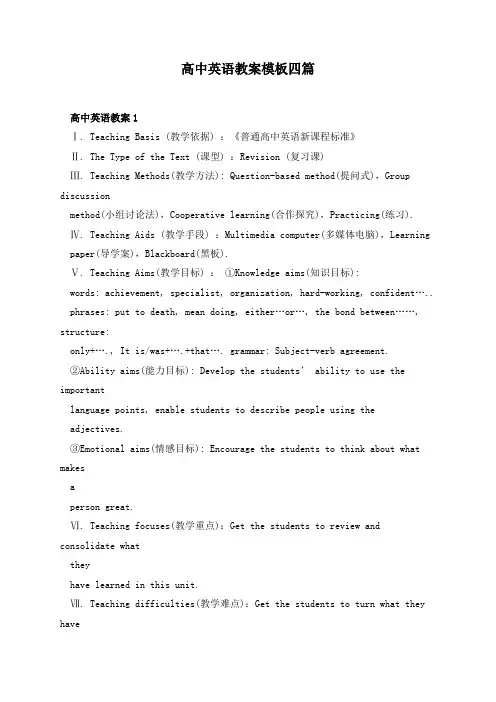
高中英语教案模板四篇高中英语教案1Ⅰ. Teaching Basis (教学依据) :《普通高中英语新课程标准》Ⅱ. The Type of the Text (课型) :Revision (复习课)Ⅲ. Teaching Methods(教学方法): Question-based method(提问式),Group discussionmethod(小组讨论法),Cooperative learning(合作探究),Practicing(练习). Ⅳ. Teaching Aids (教学手段) :Multimedia computer(多媒体电脑),Learning paper(导学案),Blackboard(黑板).Ⅴ. Teaching Aims(教学目标) :①Knowledge aims(知识目标):words: achievement, specialist, organization, hard-working, confident….. phrases: put to death, mean doing, ei ther…or…, the bond between……, structure:only+…., It is/was+….+that…. grammar: Subject-verb agreement.②Ability aims(能力目标): Develop the students’ ability to use the importantlanguage points, enable students to describe people using theadjectives.③Emotional aims(情感目标): Encourage the students to think about what makesaperson great.Ⅵ. Teaching focuses(教学重点):Get the students to review and consolidate whattheyhave learned in this unit.Ⅶ. Teaching difficulties(教学难点):Get the students to turn what they havelearned intotheir ability.Ⅷ.Teaching procedure(教学过程): Step 1 复习学案情况反馈(1分钟)Step 2 lead-in :通过图片展示的方式,过渡到知识竞答类节目《一站到底》,本节课也将模仿这种模式授课。

高中英语教案20篇1. Unit 1 FriendshipLesson 1: Introduction to FriendshipObjectives:1. To introduce the theme of friendship2. To develop students’ listening and speaking skills3. To encourage students to share their own experiences of friendshipMaterials:1. A video clip about friendship2. A worksheet with questions about friendshipProcedure:1. Show the video clip about friendship and ask students to pay attention to the different aspects of friendship that are shown.2. After the video, ask students to discuss in pairs or small groups what they saw in the video and what they think friendship means.3. Ask students to share their ideas with the class and write them on the board.4. Hand out the worksheet with questions about friendship and ask students to answer them individually.5. After students have completed the worksheet, ask them to share their answers with the class.Assessment:Students will be assessed on their participation in the class discussion and their completion of the worksheet.2. Unit 2 TravelLesson 1: Introduction to TravelObjectives:1. To introduce the theme of travel2. To develop students’ listening and speaking skills3. To encourage students to share their own experiences of travelMaterials:1. A video clip about travel2. A worksheet with questions about travelProcedure:1. Show the video clip about travel and ask students to pay attention to the different aspects of travel that are shown.2. After the video, ask students to discuss in pairs or small groups what they saw in the video and what they think travel means.3. Ask students to share their ideas with the class and write them on the board.4. Hand out the worksheet with questions about travel and ask students to answer them individually.5. After students have completed the worksheet, ask them to share their answers with the class.Assessment:Students will be assessed on their participation in the class discussion and their completion of the worksheet.3. Unit 3 HealthLesson 1: Introduction to HealthObjectives:1. To introduce the theme of health2. To develop students’ listening and speaking skills3. To encourage students to share their own experiences of healthMaterials:1. A video clip about health2. A worksheet with questions about healthProcedure:1. Show the video clip about health and ask students to pay attention to the different aspects of health that are shown.2. After the video, ask students to discuss in pairs or small groups what they saw in the video and what they think health means.3. Ask students to share their ideas with the class and write them on the board.4. Hand out the worksheet with questions about health and ask students to answer them individually.5. After students have completed the worksheet, ask them to share their answers with the class.Assessment:Students will be assessed on their participation in the class discussion and their completion of the worksheet.4. Unit 4 EnvironmentLesson 1: Introduction to EnvironmentObjectives:1. To introduce the theme of environment2. To develop students’ listening and speaking skills3. To encourage students to share their own experiences of environmentMaterials:1. A video clip about environment2. A worksheet with questions about environmentProcedure:1. Show the video clip about environment and ask students to pay attention to the different aspects of environment that are shown.2. After the video, ask students to discuss in pairs or small groups what they saw in the video and what they think environment means.3. Ask students to share their ideas with the class and write them on the board.4. Hand out the worksheet with questions about environment and ask students to answer them individually.5. After students have completed the worksheet, ask them to share their answers with the class.Assessment:Students will be assessed on their participation in the class discussion and their completion of the worksheet.5. Unit 5 EducationLesson 1: Introduction to EducationObjectives:1. To introduce the theme of education2. To develop students’ listening and speaking skills3. To encourage students to share their own experiences of educationMaterials:1. A video clip about education2. A worksheet with questions about educationProcedure:1. Show the video clip about education and ask students to pay attention to the different aspects of education that are shown.2. After the video, ask students to discuss in pairs or small groups what they saw in the video and what they think education means.3. Ask students to share their ideas with the class and write them on the board.4. Hand out the worksheet with questions about education and ask students to answer them individually.5. After students have completed the worksheet, ask them to share their answers with the class.Assessment:Students will be assessed on their participation in the class discussion and their completion of the worksheet.6. Unit 6 TechnologyLesson 1: Introduction to TechnologyObjectives:1. To introduce the theme of technology2. To develop students’ listening and speaking skills3. To encourage students to share their own experiences of technologyMaterials:1. A video clip about technology2. A worksheet with questions about technologyProcedure:1. Show the video clip about technology and ask students to pay attention to the different aspects of technology that are shown.2. After the video, ask students to discuss in pairs or small groups what they saw in the video and what they think technology means.3. Ask students to share their ideas with the class and write them on the board.4. Hand out the worksheet with questions about technology and ask students to answer them individually.5. After students have completed the worksheet, ask them to share their answers with the class.Assessment:Students will be assessed on their participation in the class discussion and their completion of the worksheet.7. Unit 7 CultureLesson 1: Introduction to CultureObjectives:1. To introduce the theme of culture2. To develop students’ listening and speaking skills3. To encourage students to share their own experiences ofcultureMaterials:1. A video clip about culture2. A worksheet with questions about cultureProcedure:1. Show the video clip about culture and ask students to pay attention to the different aspects of culture that are shown.2. After the video, ask students to discuss in pairs or small groups what they saw in the video and what they think culture means.3. Ask students to share their ideas with the class and write them on the board.4. Hand out the worksheet with questions about culture and ask students to answer them individually.5. After students have completed the worksheet, ask them to share their answers with the class.Assessment:Students will be assessed on their participation in the class discussion and their completion of the worksheet.8. Unit 8 SocietyLesson 1: Introduction to SocietyObjectives:1. To introduce the theme of society2. To develop students’ listening and speaking skills3. To encourage students to share their own experiences of societyMaterials:1. A video clip about society2. A worksheet with questions about societyProcedure:1. Show the video clip about society and ask students to pay attention to the different aspects of society that are shown.2. After the video, ask students to discuss in pairs or small groups what they saw in the video and what they think society means.3. Ask students to share their ideas with the class and writethem on the board.4. Hand out the worksheet with questions about society and ask students to answer them individually.5. After students have completed the worksheet, ask them to share their answers with the class.Assessment:Students will be assessed on their participation in the class discussion and their completion of the worksheet.9. Unit 9 Science and TechnologyLesson 1: Introduction to Science and TechnologyObjectives:1. To introduce the theme of science and technology2. To develop students’ listening and speaking skills3. To encourage students to share their own experiences of science and technologyMaterials:1. A video clip about science and technology2. A worksheet with questions about science and technologyProcedure:1. Show the video clip about science and technology and ask students to pay attention to the different aspects of science and technology that are shown.2. After the video, ask students to discuss in pairs or small groups what they saw in the video and what they think science and technology means.3. Ask students to share their ideas with the class and write them on the board.4. Hand out the worksheet with questions about science and technology and ask students to answer them individually.5. After students have completed the worksheet, ask them to share their answers with the class.Assessment:Students will be assessed on their participation in the class discussion and their completion of the worksheet.10. Unit 10 SportsLesson 1: Introduction to SportsObjectives:1. To introduce the theme of sports2. To develop students’ listening and speaking skills3. To encourage students to share their own experiences of sportsMaterials:1. A video clip about sports2. A worksheet with questions about sportsProcedure:1. Show the video clip about sports and ask students to pay attention to the different aspects of sports that are shown.2. After the video, ask students to discuss in pairs or small groups what they saw in the video and what they think sports means.3. Ask students to share their ideas with the class and write them on the board.4. Hand out the worksheet with questions about sports and ask students to answer them individually.5. After students have completed the worksheet, ask them to share their answers with the class.Assessment:Students will be assessed on their participation in the class discussion and their completion of the worksheet.11. Unit 11 ArtLesson 1: Introduction to ArtObjectives:1. To introduce the theme of art2. To develop students’ listening and speaking skills3. To encourage students to share their own experiences of artMaterials:1. A video clip about art2. A worksheet with questions about artProcedure:1. Show the video clip about art and ask students to payattention to the different aspects of art that are shown. 2. After the video, ask students to discuss in pairs or small groups what they saw in the video and what they think art means.3. Ask students to share their ideas with the class and write them on the board.4. Hand out the worksheet with questions about art and ask students to answer them individually.5. After students have completed the worksheet, ask them to share their answers with the class.Assessment:Students will be assessed on their participation in the class discussion and their completion of the worksheet.12. Unit 12 MusicLesson 1: Introduction to MusicObjectives:1. To introduce the theme of music2. To develop students’ listening and speaking skills3. To encourage students to share their own experiences of musicMaterials:1. A video clip about music2. A worksheet with questions about musicProcedure:1. Show the video clip about music and ask students to pay attention to the different aspects of music that are shown.2. After the video, ask students to discuss in pairs or small groups what they saw in the video and what they think music means.3. Ask students to share their ideas with the class and write them on the board.4. Hand out the worksheet with questions about music and ask students to answer them individually.5. After students have completed the worksheet, ask them to share their answers with the class.Assessment:Students will be assessed on their participation in the class discussion and their completion of the worksheet.13. Unit 13 FilmLesson 1: Introduction to FilmObjectives:1. To introduce the theme of film2. To develop students’ listening and speaking skills3. To encourage students to share their own experiences of filmMaterials:1. A video clip about film2. A worksheet with questions about filmProcedure:1. Show the video clip about film and ask students to pay attention to the different aspects of film that are shown.2. After the video, ask students to discuss in pairs or small groups what they saw in the video and what they think film means.3. Ask students to share their ideas with the class and write them on the board.4. Hand out the worksheet with questions about film and ask students to answer them individually.5. After students have completed the worksheet, ask them to share their answers with the class.Assessment:Students will be assessed on their participation in the class discussion and their completion of the worksheet.14. Unit 14 LiteratureLesson 1: Introduction to LiteratureObjectives:1. To introduce the theme of literature2. To develop students’ listening and speaking skills3. To encourage students to share their own experiences of literatureMaterials:1. A video clip about literature2. A worksheet with questions about literatureProcedure:1. Show the video clip about literature and ask students to pay attention to the different aspects of literature that are shown.2. After the video, ask students to discuss in pairs or small groups what they saw in the video and what they think literature means.3. Ask students to share their ideas with the class and write them on the board.4. Hand out the worksheet with questions about literature and ask students to answer them individually.5. After students have completed the worksheet, ask them to share their answers with the class.Assessment:Students will be assessed on their participation in the class discussion and their completion of the worksheet.15. Unit 15 HistoryLesson 1: Introduction to HistoryObjectives:1. To introduce the theme of history2. To develop students’ listening and speaking skills3. To encourage students to share their own experiences of historyMaterials:1. A video clip about history2. A worksheet with questions about historyProcedure:1. Show the video clip about history and ask students to pay attention to the different aspects of history that are shown.2. After the video, ask students to discuss in pairs or small groups what they saw in the video and what they think history means.3. Ask students to share their ideas with the class and write them on the board.4. Hand out the worksheet with questions about history and ask students to answer them individually.5. After students have completed the worksheet, ask them to share their answers with the class.Assessment:Students will be assessed on their participation in the class discussion and their completion of the worksheet.16. Unit 16 PoliticsLesson 1: Introduction to PoliticsObjectives:1. To introduce the theme of politics2. To develop students’ listening and speaking skills3. To encourage students to share their own experiences of politicsMaterials:1. A video clip about politics2. A worksheet with questions about politicsProcedure:1. Show the video clip about politics and ask students to pay attention to the different aspects of politics that are shown.2. After the video, ask students to discuss in pairs or smallgroups what they saw in the video and what they think politics means.3. Ask students to share their ideas with the class and write them on the board.4. Hand out the worksheet with questions about politics and ask students to answer them individually.5. After students have completed the worksheet, ask them to share their answers with the class.Assessment:Students will be assessed on their participation in the class discussion and their completion of the worksheet.17. Unit 17 BusinessLesson 1: Introduction to BusinessObjectives:1. To introduce the theme of business2. To develop students’ listening and speaking skills3. To encourage students to share their own experiences of businessMaterials:1. A video clip about business2. A worksheet with questions about businessProcedure:1. Show the video clip about business and ask students to pay attention to the different aspects of business that are shown.2. After the video, ask students to discuss in pairs or small groups what they saw in the video and what they think business means.3. Ask students to share their ideas with the class and write them on the board.4. Hand out the worksheet with questions about business and ask students to answer them individually.5. After students have completed the worksheet, ask them to share their answers with the class.Assessment:Students will be assessed on their participation in the class discussion and their completion of the worksheet.18. Unit 18 LawLesson 1: Introduction to LawObjectives:1. To introduce the theme of law2. To develop students’ listening and speaking skills3. To encourage students to share their own experiences of lawMaterials:1. A video clip about law2. A worksheet with questions about lawProcedure:1. Show the video clip about law and ask students to pay attention to the different aspects of law that are shown.2. After the video, ask students to discuss in pairs or small groups what they saw in the video and what they think law means.3. Ask students to share their ideas with the class and write them on the board.4. Hand out the worksheet with questions about law and ask students to answer them individually.5. After students have completed the worksheet, ask them to share their answers with the class.Assessment:Students will be assessed on their participation in the class discussion and their completion of the worksheet.19. Unit 19 MediaLesson 1: Introduction to MediaObjectives:1. To introduce the theme of media2. To develop students’ listening and speaking skills3. To encourage students to share their own experiences of mediaMaterials:1. A video clip about media2. A worksheet with questions about mediaProcedure:1. Show the video clip about media and ask students to payattention to the different aspects of media that are shown.2. After the video, ask students to discuss in pairs or small groups what they saw in the video and what they think media means.3. Ask students to share their ideas with the class and write them on the board.4. Hand out the worksheet with questions about media and ask students to answer them individually.5. After students have completed the worksheet, ask them to share their answers with the class.Assessment:Students will be assessed on their participation in the class discussion and their completion of the worksheet.20. Unit 20 Global IssuesLesson 1: Introduction to Global IssuesObjectives:1. To introduce the theme of global issues2. To develop students’ listening and speaking skills3. To encourage students to share their own experiences of global issuesMaterials:1. A video clip about global issues2. A worksheet with questions about global issuesProcedure:1. Show the video clip about global issues and ask students to pay attention to the different aspects of global issues that are shown.2. After the video, ask students to discuss in pairs or small groups what they saw in the video and what they think global issues means.3. Ask students to share their ideas with the class and write them on the board.4. Hand out the worksheet with questions about global issues and ask students to answer them individually.5. After students have completed the worksheet, ask them to share their answers with the class.Assessment:Students will be assessed on their participation in the class discussion and their completion of the worksheet.。
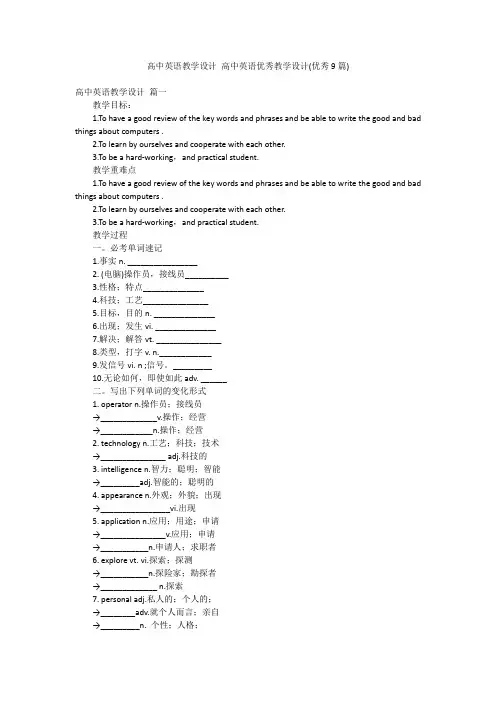
高中英语教学设计高中英语优秀教学设计(优秀9篇)高中英语教学设计篇一教学目标:1.To have a good review of the key words and phrases and be able to write the good and bad things about computers .2.To learn by ourselves and cooperate with each other.3.To be a hard-working,and practical student.教学重难点1.To have a good review of the key words and phrases and be able to write the good and bad things about computers .2.To learn by ourselves and cooperate with each other.3.To be a hard-working,and practical student.教学过程一。
必考单词速记1.事实n. ________________2. (电脑)操作员,接线员__________3.性格;特点______________4.科技;工艺_______________5.目标,目的n. ______________6.出现;发生vi. ______________7.解决;解答vt. _______________8.类型,打字v. n.____________9.发信号vi. n ;信号。
_________10.无论如何,即使如此adv. ______二。
写出下列单词的变化形式1. operator n.操作员;接线员→_____________v.操作;经营→____________n.操作;经营2. technology n.工艺;科技;技术→_______________ adj.科技的3. intelligence n.智力;聪明;智能→_________adj.智能的;聪明的4. appearance n.外观;外貌;出现→________________vi.出现5. application n.应用;用途;申请→_______________v.应用;申请→___________n.申请人;求职者6. explore vt. vi.探索;探测→___________n.探险家;勘探者→_____________ n.探索7. personal adj.私人的;个人的;→________adv.就个人而言;亲自→_________n. 个性;人格;三、用所给词的适当形式填空(1)Can you say dolphins are much more ____________than other animals?Well, they are animals of high _____________. (intelligent)(2) She expressed her _________ opinion yesterday. ____________ speaking, I agreed with what she said. (personal)(3) Any ___________ who would like to _____________ to become anassistant in our company should send us an ___________ .(apply)四、语境助记——词不离句,句不离段With the electronic technology revolution going on,simplified calculation is solved in the application on finance by universal exploration. Our goal of making life happier is certain to be realized through man's intelligence.五、翻译下列必背短语?1.在某种程度上_______________2.依…看;据…认为_____________3.从…时候起_______________4.结果_______________5.处理;安排;对付____________6.弥补,补足;整理,编造_________7.毕竟_______________?8.看守,监视_______________9.在……帮助下_______________?六。

高中英语教案英文版5篇高中英语教案英文版5篇教案可以恰当地选择和运用教学方法,调动学生学习的积极性,面向大多数学生,同时注意培养优秀生和提高后进生,使全体学生都得到发展。
以下是带来的内容,感谢您的阅读,希望能帮助到您!高中英语教案英文版1Teaching Procedures of Period 1:Step1.Warming up (15 mins)Ss know a lot about sports from everyday life and media, so I arrange sucha task -discussion(group of 4): Q: What do you know about sports?During this process, if Ss can’t express themselves in English, Chinese isalso all right. Besides, it is agood chance to present new words. If necessary, I will make somecomplements. At the same time, I will present them as many pictures about sportsas possible.Possible response:school sports meetSports meet the National Gamesthe Asian Gamesthe Olympic Gamesthe World Cupetcball games: volleyball, basket ball, football, table tennis, tennis,,golfbadminton, bowling, baseball, American football, ice hockey etcEvents of sports track and field: relay race, long jump, high jump, polejump, discus, shot, javelin etcgymnastic: rings, double bars, high and low bars, horse , free exerciseswimming/shooting/skiing/ ice sports/diving/aquatic sports etcSport stars : Beckham, Mike Owen, Michael Jordan etc Purpose: This activity is designed to encourage students to think aboutsports and activaterelevant vocabulary.Step 2. Speaking(15 mins)Task1(pair work): Talk about their favourite sports, favourite sportsstars, and the reason why they like them, with the following expressions as aguide.(See SB p52) Task2(pair work): A survey about physical fitness (Seepostscript 1)Task3(group work): Add up their total scores and divide by the number ofpeople. Then get their group’s average scores. Discuss their survey answers.1). Do you think your group is doing well or not? Why ?2). How can you become fitter?高中英语教案英文版2教学目标Teaching aims and demands本单元的教学目标是使学生掌握表示判断和个人看法的常用语句,学会使用现在完成时的被动语态。
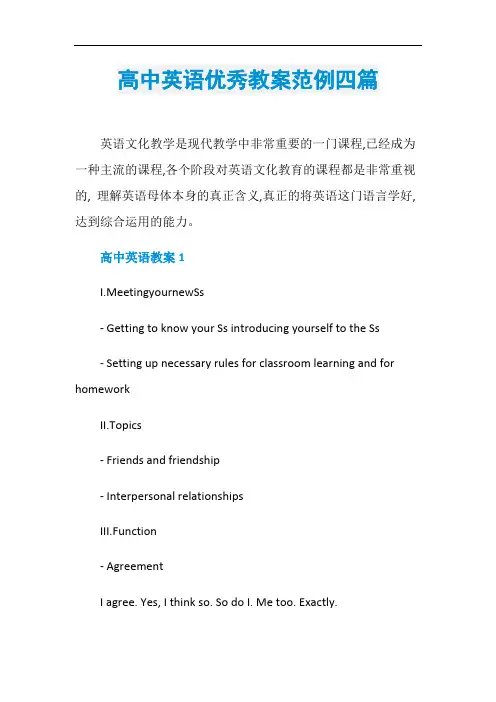
高中英语优秀教案范例四篇英语文化教学是现代教学中非常重要的一门课程,已经成为一种主流的课程,各个阶段对英语文化教育的课程都是非常重视的, 理解英语母体本身的真正含义,真正的将英语这门语言学好,达到综合运用的能力。
高中英语教案1I.MeetingyournewSs- Getting to know your Ss introducing yourself to the Ss- Setting up necessary rules for classroom learning and for homeworkII.Topics- Friends and friendship- Interpersonal relationshipsIII.Function- AgreementI agree. Yes, I think so. So do I. Me too. Exactly.No problem. Sure.Certainly. Of course. All right.You’re right/correct. Good idea.I think that’s a good idea.- DisagreementI don’t think so. Neither do I. That’s not right.Yes, but …I’m afraid not. No way.I’m sorry, but I don’t agree.Of course not. I disagree.IV.Grammar- Direct Speech and Indirect Speech (Part I. Statements and questions)1. Reporting statements“I don’t want to set down a series of facts in a diary,” said Anne.---- Anne said that she didn’t want to set down a series of facts in a diary.2. Reporting yes-no questions“Does a friend always have to be a person?” the writer asks us.---- The writer asks us if a friend always has to be a person.3. Reporting wh- questions“What do you call your diary?” Anne’s sister asked her.---- Anne’s sister asked her what she called her diary.V.Wordsandexpressionsupset ignore calm concern loose Netherlands German series outdoors dusk thunder entire entirely power curtain dusty partner settle suffer highway recover pack suitcase overcoat teenager exactly disagree grateful dislike tip swap item (32 words) add up calm down have got to be concerned aboutwalk the dog go through set down a series ofon purpose in order to at dusk face to faceno longer suffer fromget/be tired ofpack sth. upget along with fall in love join in(19 phrases)- survey vet Amsterdam Jewish Nazi Kitty spellbind loneliness Margot gossip secondly (11 words)VI.Timeallotment1st period – Warming up (P1) Workbook Listening (P41)2nd period –Pre-reading Reading Comprehension (P2-P3)3rd 4th period –Learning about Language (P4-5)5th period –Using Language (P6 Reading listening)6th period–Using Language (P7 Reading Writing)7th period–Wb Listening Task Reading Task (P43-44)8th period–Writing Task Project (P46-47)The 1st period – Warming up Using languageGoals for the 1st period:1. Introduce yourself and set up some rules for learning2. Talk about friends and friendship3. Learn the new words and expressions:upset ignore calm concern loose add up calm down have got to be concerned about walk the dogTeaching procedures:Step1Beginning1. Introduce yourself2. Set up some rules for learning:Before class: 1) Get into the classroom at the first bell.2) Get everything and yourself ready for the class.In class: 1) Follow the teacher closely and work with your mind.2) Take an active part in classroom learning activities.3) Take notes and raise questions.4) Speak English as much as you can.After class: 1) Finish your homework on time and hand it in as required.2) Review what you’ve learned in class in time.3) Preview your lesson as required.Step2Warmingup1. Introduce the topic Friendship. Ask Ss if they have a very good friend and why he or she can be their good friends.(Collect the adjectives/nouns Ss use to describe their friends on the Bb.)Supplements:Poem 1 Friends Poem 2 Auld Lang SyneBy Jill EgglestonBy Robert BurnsFriends care Should auld acquaintance be forgotFriends share and never brought to mind?We need friends Should auld acquaintance be forgotEverywhere!and days of auld lang syne?For auld lang syne, my dear,Proverbs: for auld lang syne,A life without a friend is a life withoutwe’ll take a cup of kindness yes,a sun. --- French proverbfor auld lang syne.You can buy friendship with friendship,but never with dollars.Should auld acquaintance be forgot --- Unknown and never brought to mind?A friend is a person with whom I may be Should auld acquaintance be forgotsincere. With him, I may think aloud. and days of auld lang syne?--- Ralph Waldo Emerson And here’s a hand, my trusty friendReal friendship is shown in times of trouble; And gie’s (give us) a hand o’thineProsperity is full of friends. We’ll tak’ a cup o’kindness yet---EuripidesFor auld lang syne.2. Think: What qualities and behaviors make a good friend?(a. Let the Ss make a list of 3-5 qualities a good friend should have.b. Have them work in group of four to collect the list of words.c. Then ask one from each group to write the words on the Bb.)3. Have the Ss do the survey in the Sb P1.4. When they have completed it, have Ss look again at the list on the Bb to see whether it should be revised.Explanation of each item:Q1: A: 1 point B. 3 points C. 2 pointsThis question deals with how thoughtful you are towards others: How much do you value your friend? Would you change the time of the day to go to the cinema to fit in with him/her?Q2: A: 1 point B. 2 points C. 3 pointsThis question is concerned with fairness: Is it fair for your friend to borrow something, break it and return it broken?Q3: A: 1 point B. 2 points C. 3 pointsThis question deals with your concern for others: Should you make the troubles of your friend more important than your own responsibilities?Q4: A: 3 point B. 2 points C. 1 pointsThis question is concerned with responsibilities to a friend. If you are asked to look after something and it is broken or harmed, what should you do?Q5: A: 0 point B. 2 points C. 0 pointsThis question is concerned with honesty.5. Quickly deal with the meaning of the new expressions in this part. We’ll later practice them in Ex 1, 2, 3 in Learning about language on Sb P.41) add up: v. to add sth. together2) upset: adj. sad, unhappy3) ignore: v. pay no attention to4) calm…down: v. make sb. calm, comfort sb.5) have got to …: v. have to do sth.6) be concerned about: v. be worried about, care about7) walk the dog: v. exercise the dog8) loose: adj. not tight重点词汇用法的学习,例如:1. add: add ... to;add to; add up; add up to;Eg. Will you please add some milk to my coffee?The little baby adds to our enjoyment at the party.Add up your score and see how many points you get.Add up these figures foe me, please.All the money I have in my pocket adds up to $ 125.2. upset: adj. worried, annoyed; v. cause to worry, to be sad/angryEg. I was very upset because one of my friends was rude to me.His cheating in the exam upset his teacher.3. ignore: v. pay no attention to; to behave as if you had not heard or seen sb./sth. n. ignoranceEg. You can’t ignore the fact that many criminals never go to prison.These are the problems which we can’t afford to ignore.Sam rudely ignored the inquiry.He had completely ignored her remark, preferring his own theory.4. calm: v. calm downEg. The mother calmed the baby by giving him some milk.What the manager said calmed the fears of the works.We tried to calm him down, but he kept shouting and crying.Calm down. There’s nothing to worry about.5. concern: v. concern sth.; be concerned about /with/ for sb. / sth.; n.Eg. This case concerns the group of people greatly.What I said at the meeting doesn’t concern you, so don’t worry about it.Our head teacher is concerned about our study and health all the time.He has never been concerned about/for what others think of him.He seemed to be concerned with the case.Your school work, rather than your private life, is my concern.My greatest concern is the development of our school.6. walk the dog: to take a dog for a walkEg. He is out walking the dog.walk sb home/ to a placeIt’s late --- let me walk you to the bus stop.6. If necessary, the T may ask one or two Ss the following questions:a. What kind of person are you according to the survey?b. Do you think you can be a good friend to others? And how?c. What do you think are the basic elements we need to keep our friendship?Step3ListeningWorkbook Listening on P411. Before you listen, discuss these questions with the class.1) Do you think it is a good idea to make friends with people from other countries?(to broaden one’s world outlook; to avoid national stereotypes etc.)2) What are the advantages of this friendship?(to practice another language with a native speaker; to learn new ideas and new ways of thinking; to find out more about another country etc.)2. the 1st Listening of Part 1: Write down what Leslie does in China in one sentence.(Leslie does some business in China and her company sells buses.)3. the 2nd Listening of Part 1: Tick the things done by Leslie.(going out for delicious dinners; visiting a mountain; going to people’s homes)4. the 1st Listening of Part 2: What does Leslie say about the friends she made in China?(1) Leslie says that she make friends but they are just business friends because she thinks one cannot make friends on a short visit.(2) Leslie thinks some of the friends in China may have liked her, but others may try to be nice to her so as to gain a business advantage.Step4Homework1. Make sentences with the 8 new words and expressions.2. Prepare and read aloud the rest new words.The 2nd period – Pre-reading Reading ComprehensionGoals for the 2nd period:1. Have Ss read the text and try their best to understand Anne’s eagerness for friends, friendship, nature and freedom.2. Get Ss have some knowledge about the Nazi’s cruel deeds towards the Jews during the Second World War.3. Train Ss’ reading ability of scanning and skimming. Learn to appreciate Anne’s Diary , the classic work.高中英语教案2课题:Friendship\(2)教材分析与学生分析:本单元的中心话题是“友谊”,几乎所有的内容都是围绕这一中心话题展开的。
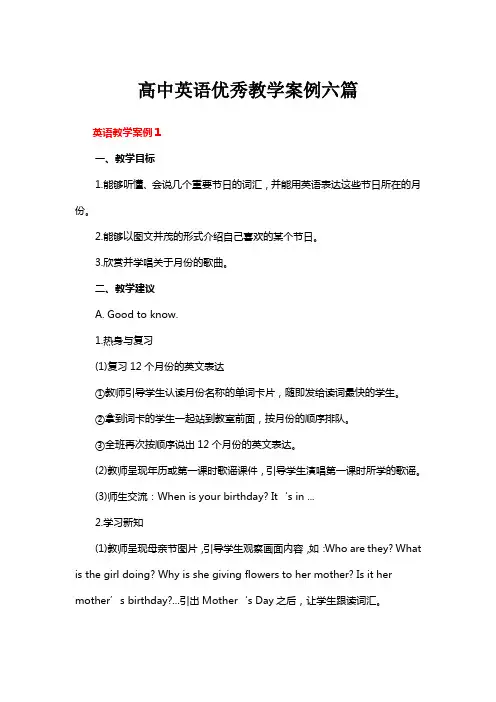
高中英语优秀教学案例六篇英语教学案例1一、教学目标1.能够听懂、会说几个重要节日的词汇,并能用英语表达这些节日所在的月份。
2.能够以图文并茂的形式介绍自己喜欢的某个节日。
3.欣赏并学唱关于月份的歌曲。
二、教学建议A. Good to know.1.热身与复习(1)复习12个月份的英文表达①教师引导学生认读月份名称的单词卡片,随即发给读词最快的学生。
②拿到词卡的学生一起站到教室前面,按月份的顺序排队。
③全班再次按顺序说出12个月份的英文表达。
(2)教师呈现年历或第一课时歌谣课件,引导学生演唱第一课时所学的歌谣。
(3)师生交流:When is your birthday? It‘s in ...2.学习新知(1)教师呈现母亲节图片,引导学生观察画面内容,如:Who are they? What is the girl doing? Why is she giving flowers to her mother? Is it her mother’s birthday?...引出Mother‘s Day之后,让学生跟读词汇。
英语教学案例2一、语言技能目标第一层次:1.能够听懂、会说衣服词汇cap,coat,shoes,sweater,jacket,gloves,trousers;能在四线三格中基本规范地抄写单词,并尝试借助拼读规律记忆单词。
2.能够听懂、会说用来介绍复数衣服的功能句:These are ...3.能够听懂、会说用来询问自己该穿什么衣服的功能句:What should I wear today?及其答语:You should wear ...,初步学会在恰当的情境中运用,并通过描摹句子来体会句子书写规范,为抄写句子和独立写句子打基础。
4.能够读懂介绍自己所在城市的季节、天气、穿衣情况以及询问对方城市相关情况的小书信;并通过替换小书信中的关键信息回信,介绍自己的上述情况,回复朋友的询问。
5.能够借助熟悉的旧单词和图片感知字母u在闭音节单词中的发音规律,并利用该规律拼出新单词的读音,进而尝试记住其写法。
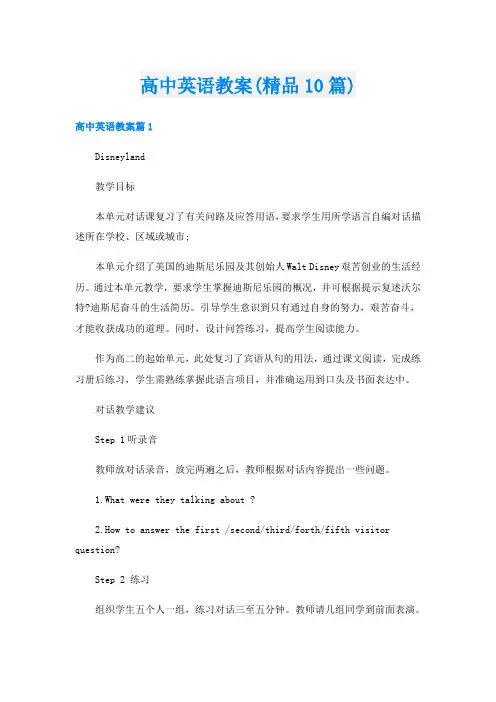
高中英语教案(精品10篇)高中英语教案篇1Disneyland教学目标本单元对话课复习了有关问路及应答用语,要求学生用所学语言自编对话描述所在学校、区域或城市;本单元介绍了美国的迪斯尼乐园及其创始人Walt Disney艰苦创业的生活经历。
通过本单元教学,要求学生掌握迪斯尼乐园的概况,并可根据提示复述沃尔特?迪斯尼奋斗的生活简历。
引导学生意识到只有通过自身的努力,艰苦奋斗,才能收获成功的道理。
同时,设计问答练习,提高学生阅读能力。
作为高二的起始单元,此处复习了宾语从句的用法,通过课文阅读,完成练习册后练习,学生需熟练掌握此语言项目,并准确运用到口头及书面表达中。
对话教学建议Step 1听录音教师放对话录音,放完两遍之后,教师根据对话内容提出一些问题。
1.What were they talking about ?2.How to answer the first /second/third/forth/fifth visitor question?Step 2 练习组织学生五个人一组,练习对话三至五分钟。
教师请几组同学到前面表演。
Step 3改写将对话内容改写为一篇短文,要求学生用本课的地点名称如:Sleeping Beauty Castle , Bear Country, Horse-drawn streetcars, the Tomorrow Land Building比如:Carl is answering visitors’ questions. The first visitor asks Carl the way to the Sleeping Beauty Castle….Step 4 讨论If you are visitor, How to ask the way to the stranger at first?Step 5总结教师提问学生们,归纳和总结对话用语。
Asking:Where is …...How can I get to…Which is the way to…Could you tell me if…Could you tell me the way to…Answering:Go straight ahead…It’s behind …/in frond of/Go down this street…教材分析本课的日常用语用语是有关对话asking the way and responses,这样的问路用语在初中都以学过,所以对话不在是个难点。
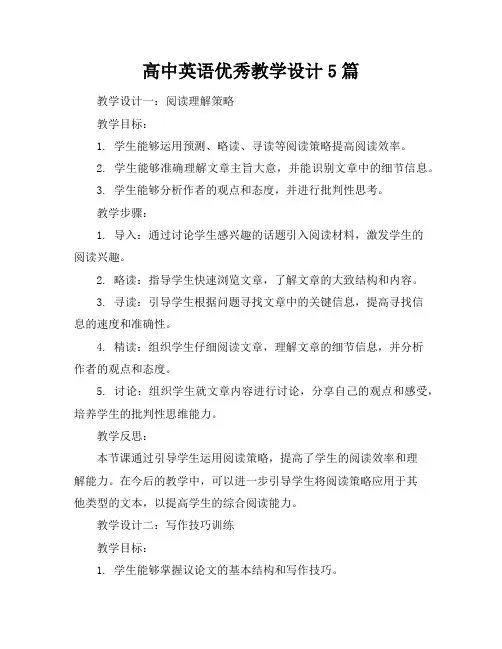
高中英语优秀教学设计5篇教学设计一:阅读理解策略教学目标:1. 学生能够运用预测、略读、寻读等阅读策略提高阅读效率。
2. 学生能够准确理解文章主旨大意,并能识别文章中的细节信息。
3. 学生能够分析作者的观点和态度,并进行批判性思考。
教学步骤:1. 导入:通过讨论学生感兴趣的话题引入阅读材料,激发学生的阅读兴趣。
2. 略读:指导学生快速浏览文章,了解文章的大致结构和内容。
3. 寻读:引导学生根据问题寻找文章中的关键信息,提高寻找信息的速度和准确性。
4. 精读:组织学生仔细阅读文章,理解文章的细节信息,并分析作者的观点和态度。
5. 讨论:组织学生就文章内容进行讨论,分享自己的观点和感受,培养学生的批判性思维能力。
教学反思:本节课通过引导学生运用阅读策略,提高了学生的阅读效率和理解能力。
在今后的教学中,可以进一步引导学生将阅读策略应用于其他类型的文本,以提高学生的综合阅读能力。
教学设计二:写作技巧训练教学目标:1. 学生能够掌握议论文的基本结构和写作技巧。
2. 学生能够运用论据和论点进行有效的论证。
3. 学生能够进行自我修改和同伴互评,提高写作水平。
教学步骤:1. 导入:通过分析优秀议论文,引导学生了解议论文的基本结构和写作技巧。
2. 写作指导:讲解议论文的写作步骤,包括确定论点、寻找论据、组织文章结构等。
3. 实践练习:组织学生进行写作练习,并鼓励学生运用所学技巧进行创作。
4. 同伴互评:引导学生进行同伴互评,互相提出修改建议,提高写作水平。
5. 自我修改:指导学生根据同伴互评和自我反思进行修改,完善文章。
6. 展示与分享:组织学生展示自己的作品,并分享写作心得和体会。
教学反思:本节课通过讲解写作技巧和实践练习,提高了学生的写作能力。
在今后的教学中,可以进一步引导学生关注写作过程中的细节问题,如语法、拼写、标点等,以提高学生的写作质量。
教学设计三:口语交际能力提升教学目标:1. 学生能够运用恰当的口语表达技巧进行日常交流。
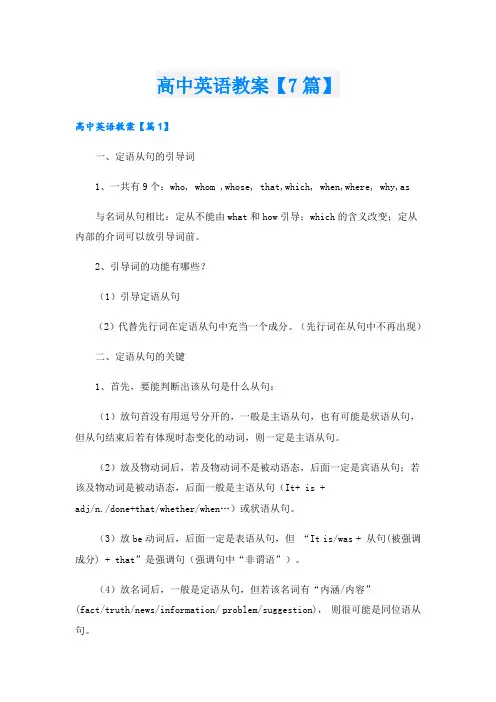
高中英语教案【7篇】高中英语教案【篇1】一、定语从句的引导词1、一共有9个:who, whom ,whose, that,which, when,where, why,as与名词从句相比:定从不能由what和how引导;which的含义改变;定从内部的介词可以放引导词前。
2、引导词的功能有哪些?(1)引导定语从句(2)代替先行词在定语从句中充当一个成分。
(先行词在从句中不再出现)二、定语从句的关键1、首先,要能判断出该从句是什么从句:(1)放句首没有用逗号分开的,一般是主语从句,也有可能是状语从句,但从句结束后若有体现时态变化的动词,则一定是主语从句。
(2)放及物动词后,若及物动词不是被动语态,后面一定是宾语从句;若该及物动词是被动语态,后面一般是主语从句(It+ is +adj/n./done+that/whether/when…)或状语从句。
(3)放be动词后,后面一定是表语从句,但“It is/was + 从句(被强调成分) + that”是强调句(强调句中“非谓语”)。
(4)放名词后,一般是定语从句,但若该名词有“内涵/内容”(fact/truth/news/information/ problem/suggestion),则很可能是同位语从句。
(5)用逗号分开的从句,一般是状语从句或 as/which引导的定语从句,也要注意用放在句中用逗号分开的“插入语”(however, for example,believe it or not等)。
2、其次,判断出是定语从句后可以用“三个优先”法做题:(1)优先选择含whose的选项,能与空格后的名词构成“某人的某物”搭配,一般就是答案;(2)优先选择含介词的选项,然后看该介词与从句中的谓语是否能构成符合逻辑的搭配;(3)用逗号分开的定从,优先考虑as和which,若该空能翻译为“一件事”而从句意思是通顺的,则放句首就用as,句末用which(若该空能翻译为“如同”“像…一样”则应用as)3、再次,做定语从句题可以用“三问法”来检测是否出错:(1)先行词本身是否为特殊的词?way+ in which/that/省略指物的不定代词:anything, one, some,many, a lot, all, both, that 等 + that指人的不定代词或数词:one, those, anyone, two等 + who既有人又有物: + that“抽象的地点”condition, situation,case, point + where“抽象的时间”one’s stay/visit + when在特定语境中可以作“地点/位置”理解的词:trousers/ sleeves + where(2)先行词前面有无特殊的词?有不定代词修饰:all/every/little/much+ …+ that有最高级/序数词修饰:the best/second … + that有just the/ the very/ the only/ the last等修饰:+ that有who/which疑问词:+ that(避免重复)有the same/ such/ as修饰:一般+ as(注意:①第一个as是否为一个以as结尾的搭配,如regard…as;②区分such…as(定从)与such …that“如此…以至于”)(3)先行词在定语从句中充当什么成分?注意:从句中spend后的“时间”,以及visit后的“地点”,不是状语,而是宾语,应该用不定代词4、只能用that引导定语从句有哪些情况?先行词前为all, everything, nothing,something, anything, little, much等不定代词时;先行词前有:all, every, no, some, any,little, much, few等不定代词修饰时;先行词被序数词修饰时;先行词被形容词最高级修饰时;先行词前only, just, very, last有等修饰时;先行词是表示人和物混杂的两个名词时;主句是以who, which,开头的疑问句或先行词是疑问代词时;在修饰时间、地点等先行词时,只有用that代替when, where等引导词;【例】Ill never forget the Sunday (that) you first arrived.Do you know anywhere (that) I can get a drink ?先行词为reason, way (意为“方法”)时,常用that 代替why,which, in which,也可省略。
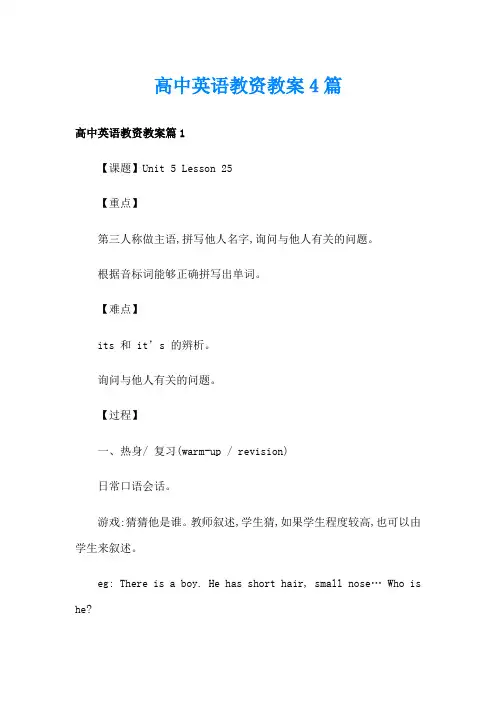
高中英语教资教案4篇高中英语教资教案篇1【课题】Unit 5 Lesson 25【重点】第三人称做主语,拼写他人名字,询问与他人有关的问题。
根据音标词能够正确拼写出单词。
【难点】its 和 it’s 的辨析。
询问与他人有关的问题。
【过程】一、热身/ 复习(warm-up / revision)日常口语会话。
游戏:猜猜他是谁。
教师叙述,学生猜,如果学生程度较高,也可以由学生来叙述。
eg: There is a boy. He has short hair, small nose… Who is he?学生用He is …或 His name is…回答。
说说自己:介绍一下自己的情况,复习第四单元内容,同时为新课做准备。
二、呈现新课(presentation)教师展示图片 ( 小猫和小鸟 )教师问:Who is she? Who is he? What are their names?Do you know how to spell their names?教师播放腾图教育资源中的配套课件。
回答刚才教师的提问。
模仿课文对话。
教师播放声音,学生跟读。
两人一小组,练习对话。
请几组到前面来表演。
学习单词:教师读词,由学生试着拼字母。
教师带读单词。
学生做拼读练习。
游戏:看看哪组写的快:发给每组一张小纸条,从排头开始写:Can you spell your name?这句话,然后向后传,看哪组写得快,哪组写得好。
三、趣味操练(practice)给课件配音:教师播放课件,但关掉声音,由学生来配音。
自编小对话:学生自愿结合,编写小对话。
请几组到前面来表演。
师生共同给予评价。
看图练习:教师或学生做示范:I have a bird. Its name is [′pCli ]. [ ka:l] [′mimi] [rEUz] [sAm] [keit] Can you spell its name?让几个同学模仿。
( 第51页练习 )待学生明白教师的要求后,学生在小组中练习。

高中英语教案设计(精选15篇)高中英语教案设计【篇1】高一上学期是高中教育的起始阶段,是一个全新的起点,因此这一阶段的教育显得尤为重要。
而我,作为一名新的教师,同样和学生站在了新的起跑线上。
为了让自己能顺利进行新课标的教学任务,也能使学生-完成新课标的各项学习要求,尽快适应新的环境,以便他们在各方面能够健康发展。
而我也必须严格要求自己,力争把英语教学搞的有声有色,特制定英语教学计划如下:一、教材分析教材是“课标”的具体表现,是学生学习的“蓝本”。
现在使用的人教版每一个单元都围绕一个主要话题开展听说读写活动,共九个部分,即热身,阅读,理解,语言学习,语言运用,小结,学习建议和趣味阅读。
语言知识和技能的呈现与训练,以及语法和句型等重点循序渐进,循环反复,符合学生的认知规律,有利于学生构建知识系统。
新教材打破了传统的体系,用新的理念、新的方式、新的体系呈现出来。
我们应当以积极的态度去学习新教材,研究新教材,理解新教材各个栏目的编写意图,限度地发挥各个栏目的作用。
一方面我们要努力去理解新教材、适应新教材、用好新教材,一方面我们又要努力站在新教材之上使用新教材,要根据教学目标和学生实际对其进行大胆的取舍和重组,力争做到教材为我所用。
二、教学目标1、使学生明确学习英语的目的性,发展自主学习的能力和合作精神;2、做好初高中的教学衔接工作,让学生了解和适应高中的英语学习;3、在培养学生的语言知识、语言技能、情感态度、学习策略和文化意识等素养的基础上发展学生综合运用语言的能力,培养学生在获取信息,处理信息,分析问题解决问题的能力,以及运用英语进行思维和表达的能力。
4、优化学生的英语学习方法,使他们能通过观察、体验、探究等主动学习的方法,充分发挥自己的学习潜能,形成有效的学习策略,提高自主学习的能力。
三、学生现状分析我所带的班级是高一年级5班和6班。
总体来说,学生生源构成复杂,大部分学生来自农村,城区学生较少,普遍英语底子差,基础薄,英语水平参差不齐,做题方法不得当,而且大部分学生对英语有一种畏惧感或者是厌学。
英语公开课优质教案大全3篇高中英语优质公开课教案下面是分享的英语公开课优质教案大全3篇高中英语优质公开课教案,以供参考。
英语公开课优质教案大全1教学目标:1. 语言知识目标:Words—复习有关animals的单词。
学习新单词:hen, sheep, cow, horse, goat, lamb以及复数的表达方式。
Sentences—熟练掌握下列句子,并能熟练运用。
What are they? They are goats.Are they…? Yes, they are. No, they aren’t.能听写指示语,并做出相应的动作,如:Milk a cow.2. 情感、文化目标:(1)在教学过程中培养学生学习兴趣,帮助他们树立信心。
(2)使学生能掌握以得体的方式与人交际。
一、教学重点、难点:教学重点是掌握农场上常见的牲畜的名称。
教学难点是“horse”与“house”的发音区别,掌握”lamb”的发音以及复数形式的表达。
二、课前准备:1.PC复读机课文MP3格式。
2.教师准备单词卡片:hen, cow, horse, goat, lamb,sheep.和复数图。
三、教学步骤:1. Greeting.2.音标组合操练(一)(1) 播放PC 复读机播放sheep请两位同学上来写听到单词的音标其余同学在下面写[∫i:t ] 分析音标后根据发音规则写出单词sheep sh /∫/ ee /i:/P /p/ 学生拼写单词。
模仿跟读PC复读机手势加音标出示卡片绵羊(2) 播放PC复读机播放horse请两位同学上来写听到单词的音标其余同学在下面写[h):s ] 根据发音规则写出单词horse h / h / or / / s / s /学生拼写单词。
模仿跟读复读机出示卡片马用相同的办法学习hen cow lamb goat单词学习结束听写句子What are they ?They are goats .展示复数图片分别教其它的复数形式(二)。
高中英语教案(优秀6篇)在本单元教学中,学生学习并初步掌握非限制性定语从句的用法,并运用到书面作业中。
进一步学习提出建议的表达方式,能较为熟练的提出建议,语言使用正确。
一起看看人教版高一英语必修二全册教案!欢迎查阅!的精心为您带来了6篇《高中英语教案》,亲的肯定与分享是对我们最大的鼓励。
高中英语教案篇一学习目标Students are to be able topredict what to hear.use the group of words related to stress.tell the ways to deal with the stress.教学流程学生背景升入高中后的'第二节英语课。
教学内容1) Listen to an interview concerning stressful situations2) Predict before listening教学目的1) To identify stressful situations.2) To use stress related words and expressions.3) To learn about ways of dealing with stress.4) To predict before listening.教学过程步骤教师活动学生活动时间教具板书可能遇到的问题Lead inAsk questionsWrite down key words on the Bb Answer the questionsGet familiar with the topic 2’ PicturesComputer TitleNew words and key sentences Ss might not use the target wordsIntroduceLexicalItems inContextWrite down model sentences on the Bb Brainstorm and talk about stressful situations 3’Textbook Model sentences Differences betweenvery, quite vs.a littleCheck point Ex. 2 Page 10 Focus on the form, meaning and use of the lexical items 3’Textbook Key words Ss might have difficulty producing the answer:stress pressurePrediction Introduce the technique of prediction Ss use the technique to predict answers individuallyJustify their opinions in pairs 5’ Textbookputer No Ss’ individual differencesListeningPlay the cassetteHighlight the strategiesPlay the cassettetwice Listen for general information to check the answers 10’ ComputerTextbook No Some Ss might feel depressed after checking, then they need encouragement Listening Play the cassette for the third timeEncourage Ss to choose suitable ways to answer the 3 questions based on their abilityHelp Ss to find the right answers Listen for specific information to answer the questionGet enough information on stress and learn the ways to deal with stress 12’TextbookAnswer sheetComputer NoSs might over or under- estimate their own ability to answer the questionsSs might not be able to collect enough specific information to finish the taskGive Suggestions Offer a chance for Ss to evaluate their study Solve practical problems in their life in groupsPresentationEvaluation 10’ Answer sheets Evaluation formThe suggestions might be quite different based on individual differences, whatever the results everyone should be awardedHomework Read Supplementary Reading on P7 P9高中英语教案精选篇二Revision1. Ask students some questions to revise the last lesson(show them on the screen).a. How much salt do the oceans contain per thousand parts of water?(35 parts of salt. 3.5% by weight)b. What is coral? Why are corals not found in deep water?c. Why is the Dead Sea called the Dead Sea?2. Check the homework(made a survey about the sea or sea life by surfing the Internet or asking for help from other people). Through this part we can consolidate what they studied yesterday, municate with others about their survery results and prepare for the new lesson.高中英语教案范文Step 3Lead-in and preparation for readingShow them some pictures and let them talk each other, and then use the pictures about sea and life in the oceans to learn new words, for example, Antarctica, huge whale, sperm whale, squid and so on.Purpose: Arouse the students’ interest of study.Bring in new subject: Life in the oceans.高中英语教案篇三(1)课题:Friendship(2)教材分析与学生分析:本单元的中心话题是“友谊”,几乎所有的内容都是围绕这一中心话题展开的。
高中英语教案模板(15篇)高中英语教案模板(精选篇2)高中英语教案模板(精选篇7)高中英语教案模板(精选篇8)教学预备教学目标1、把握下列词汇和短语: reason, list, share, feelings, Netherlands, German, outdoors,Crazy, nature, dare, thundering, entirely, power, trust, indoors, go through,hide away, set down, a series of, on purpose, in order to, face to face,according to.2、进一步学习有关“伴侣”的学问信息,启发同学对伴侣和友情的思索。
3、了解《安妮日记》的背景学问,在感受外国文化的同时,深刻理解安妮日记的内涵,同时提高同学文化意识。
4、训练同学肯定的阅读技巧,使他们把握一些有效的学习策略,从而提高阅读速度和理解的精确性,并养成肯定的自主学习力量。
5、培育同学快速阅读的力量、捕获信息的力量及运用语言进行交际的力量。
6、通过个人活动、小组活动和班级活动等方法,培育同学的合作互助精神,共享英语学习的阅历,感受用英语沟通的胜利和喜悦。
教学重难点教学重点:1、了解《安妮日记》的背景学问,在感受外国文化的同时,深刻理解安妮日记的内涵,同时提高同学文化意识。
2、训练同学的阅读技巧,提高同学阅读速度和理解力量。
教学难点:对所获得的信息进行处理、加工和学习,形成有效的学习策略。
教学工具ppt课件教学过程...板书Uint1 Reading Anne’s Best FriendQualities: easy-going ,warm-hearted ,helpful,… Questions:SkimmingSummarizeDiscussion: 1 style 2 ideas高中英语教案模板(精选篇9)教学目标To help students learn to express attitudes, agreement disagreementand certaintyTo help students learn to read the text and learnto write diaries inEnglishTo help students better understand “friendship”To help students learn to understand and use some important words andexpressionsTo help students identify examples of Direct Speech Indirect Speech(I): statements and questions in the text教学重难点Wordsupset, ignore, calm, concern, settle, suffer, recover, packExpressionsadd up, calm down, have got to, be concerned about,go through, set down, aseries of, on purpose, in order to, at dusk, face to facer, no longer/ not …anylonger, suffer from, get/ be tired of, pack (sth.) up, get alongwith, fall inlove, join inPatterns“I don’t want to set down a series of facts in a diary as most people do,”said Anne. →Anne said that she didn’t want to set down a series of facts in adiary as most people do.I stayed awake on purpose until half past eleven……it was the first time in a year and a half that I’d seen the night face toface…教学工具ppt教学过程Hello, everyone. I’m so glad to be your teacher of English. I’d like tomake friends with you, to build up a close friendship with you. Today we shalltake Unit 1. The topic of this unit is Friendship. What do you think friendshipis?1. Warming up⑴ Warming up by defining friendshipHello, everyone. I’m so glad to be your teacher of English. I’d like tomake friends with you, to build up a close friendship with you. Today we shalltake Unit1. The topic of this unit is Friendship. What do you think friendshipis?Yeah, there are many explanations about friendship. However, friendship isa relationship that can’t be restricted(限制)by definition(定义). It can only beexperienced. True friendship can exist between any two souls, be it betweenpeople or animals. It can happen at any moment, to anyone. Even to lifelessthings, like a diary, a ball, a friendship can happen.Then what is your opinion about friendship?Do you think that friendship is important to our life? Why?⑵Warming up by learning to solve problemsNice to meet you, class. We shall be friends from now on. For everybodyneeds friends. But being a good friend can sometimes be hard work. Learning howto solve problems in a friendship can make you a better friend and a happierperson. Discuss the situation below and try to solve the problems wisely.Common problems among teenagersSolutionSome of the common problems include forgettingfriends’ birthday, notkeeping promises, letting out friends’ secrets and so on.Maybe we can have a heart-to-heart talk with our friends to ask forforgiveness.Situation 1: Friends get angry with each other when they try to talk aboutsomething difficult.Try to understand your friend/ Try to talk about the problem in a differentway.Situation 2: Friends don’t know how to apologize Start by telling each other that you are sorry. A simple apology is oftenenough and is a good starting point.Situation 3: Some friends don’t know how to keep secrets.Keep your secrets to yourselfTips on being a good friendTreat your friends the way you want to be treated. Keep secrets that aretold to you.Pay attention when your friend is talking. Keep your promises. Share thingswith your friend. Tell your friend the truth. Stick up for your friend.⑶Warming up by doing a surveyGood morning, class. I am your teacher of English. Glad to be here withyou. Today we shall take Unit 1 Friendship.To be frankly, I’d like very much to keep a close friendship with you, mydear students, in the following years. How about you then? Ok, thanks. I do hopeto be your good teacher as well as your helpful friend (良师益友).Now please do the survey on page one.Add up your score according to the scoring sheet on page 8. You don’t haveto tell your results. You can just keep it a secret.高中英语教案模板(精选篇10)教学目标1. To practise listening comprehension.2.To practise making decisions and reasoning教学重难点1. To practise listening comprehension.2.To practise making decisions and reasoning教学工具课件教学过程Step1. revision1. check the homework exercises.1). It has been reported that children will be offered free education.It has been reported that free education will be offered to children.2). It has been said that we will be offered the latest computer science course book.It has been planned that the latest computer science course book will be offered to us.3). I have been told by Peter that I will be lent his notebook computer for a week.I have been told by Peter that his notebook computer will be lent to me for a week.2. Question: What can computers be used as?Step2. Lead-inAs we know, science and technology is developing very fast and computers have become smaller and smaller. They have been used in many fields. So, the 21st century is the century of information technology What does it mean? Does information technology/ IT only mean thingslike computers? Of cause not. Actually, it means more than computers. Computers are just one kind of IT. What else do you know is part of IT?(TV, radio, CD-ROM, DVD, books……)Step3. Listening (SB)1. Pre-listening: What are the changes brought by different forms of IT ?What are the advantages and disadvantages of them ?2. While-listening:Go through the chart and make sure the students look at the chart before they listen to the tape. (This is to sharpen their attention and listen for the answers. This will also help them get the gist of the text.) Then Listen to the tape and finish filling in the chart. (If necessary, play the tape for several times.)Say: After listening to their talk, we know all kinds of IT have both disadvantages and advantages.Let’s check the answers together.Type of IT Advantages DisadvantagesTV You can both listen and watch. You cannot write to friends.Web You can find information. It is very expensive.Radio You can listen to English. You cannot watch a film.Book You can get information. Sometimes it is out of date.3. Post-listening:1) (pair work): decide which type of IT is best for you to use right now. Make your choice and give your reasons by using the following expressions.I think that….In my opinion, ….I believe that….I agree because….I disagree because….I’ve decided that….2) (group work): Discussion :Computers are useful and have brought us lots of good things, but they also cause bad effects. What attitude should we have towards the computer? (Make good use of it but never get trapped by it.)Step4. Speaking1. Pre-speakingSay: From what we have learn, we should admit thatcomputers and the web have a great influence on the school education as well as people’s life. It has come into people’s everyday life and many families hold computers in their homes. Now there is a task for you.2. While-speaking1) Situation: You have been asked by your parents to help choose computers for your home. You and your friend have looked at several computers. Talk about the special things each computer can do. Make a decision about which kind of computer to buy and explain why. Information input: Show students some pictures of different computers (desktop computer laptop computer …)Language input: Useful expressions (Repeat it to strengthen students’ ability of use it.)Supporting an opinion Challenging an opinionI think that … , because … Perhaps, but what if / about …First, … Have you thought about …One reason is that … What makes you think that I think it is better because… I don’t like it because….(Pair work )Use the expressions to support your opinion or challenging other’s opinions.2) Oral report: (individual work )Do an oral report to your father and start your report like this: I looked at many different computers. The one I have chosen is the PEP personal computer. One of the main reasons is that it is suitable for homes.I found that…3. Post-speakingConclusion—What useful expression do we use to make a decision and reason?(In this way, they can review and use the words and phrases again.)Step6 Pre-writingSay: Imagine what problems and delights this android might have to deal with while it is serving you. Try yourself in someone else’s shoes is an important way of understanding how other people feel.Then discuss: You are an android. You work for a family with one child who is very spoiled. The parents want you to do everything for them. The parents are nice, but they often ask you to watch over their child. Howdo you feel? What would you do if the child asked you to do his/her homework for him/her? Would you ever tell the child “no”?Step7 WritingSay: Write a passage about the result of your discussion! It should contain:What do you have to do?What is the child like?What is the parents’ requirement of the child? What do the parents want you to do?What does the child want you to do?Then what will you do? How do you feel?Sample writing:Hello everybody, my name is Liu Yan.I am a 321 model android.I work for the Li family. Mr and Mrs Li work very hard too.Mr Li is an architect and designs great tall apartment blocks.Mrs Li is a doctor and has to look after many patients.I remember all the plans for Mr Lis projects and can tell Mrs Li which drugs are the best to give any particular patient. And I also look after their library. I store all the books that they borrow from their school or friends in my brain.Of course mybrain is as large as a mountain, so work like that is no trouble to me.I really eat books just like people eat food.The Lis have a child who is very spoiled. He needs me to remember all his school textbooks so that I can do his homework for him.He just gives me the information on the subject, what has to be done and the page numbers and I get on with it while he enjoys himself with his friends.Sometimes I dont think it is right to do his homework for him — its somewhat cheating. However, his parents are very concerned at the pressure of work in school these days.The child has too much homework to do. They like him to go to the key school but they also want him to be able to have hobbies, learn to swim and keep fit! Poor child!So they consider me the most important person in the family after themselves.I am always introduced to their friends and play with visiting children.I am the perfect family academic aid and, although I was not cheap to buy, Mr Li says I was worth every yuan!Step8 AssessmentGet the students to assess their writing abilityaccording to the following the questions:1. Is your composition well developed?2. Are your ideas well organized to the point?3. Do you have a good choice of words and idioms in your writing?4. Do you get a good mastery of complex structures of language?5. What kind of mistakes have you made in your writing?Step9: HomeworkWrite about your discussion. You may begin like this:Hello, everyone. My name is __X. I’m 321 model android. I work for the Li family….课后小结学了这节课,你有什么收获?课后习题完成课后习题一、二。
⾼中英语教案模板(通⽤5篇)⾼中英语教案模板(通⽤5篇) 作为⼀名教师,时常需要⽤到教案,教案是保证教学取得成功、提⾼教学质量的基本条件。
我们应该怎么写教案呢?下⾯是⼩编帮⼤家整理的⾼中英语教案模板(通⽤5篇),欢迎⼤家分享。
⾼中英语教案1 ⼀、教学内容分析 本单元的中⼼话题是西⽅绘画艺术的历史和中西⽅各种艺术形式和风格。
听说读写都是围绕这个⽽展开的。
这节课的内容主要是围绕中国的绘画艺术的历史和风格及其各个时期的代表作品⽽展开的。
通过做听⼒训练和热⾝,让他们对艺术和绘画有⼀个⼤概的了解,从⽽为接下来西⽅艺术的学习垫定基础。
⼆、教学⽬标 1.aims of knowledge(知识⽬标) 1) to know the information about art 2) to know some relevant words and expressions 2.aims of abilities(能⼒⽬标) 1) to improve students listening ability by guessing the content and setting down the key words 2) to enable the students to understand the brief short history of the traditional chinese painting 3.affective aims(情感、态度与价值观⽬标) to arouse the patriotic spirit of the students and improve their team spirit by doing the group work 三、学习者特征分析 虽然这是选修七第⼀单元的第⼀个课时,学⽣在语⾔理解上会有⼀定障碍。
我们班学⽣男⽣为⼤多数,普遍听⼒较薄弱,也⽐较缺乏兴趣。
但是⾼⼆的学⽣通过⼀年多的⾼中英语学习,已经积累了⼀定的词汇,⽽且在听听⼒之前教师会让学⽣做热⾝,先熟悉⽬标词汇,使听⼒难度降低。
高中英语教案(优秀8篇)高中英语教学设计篇一单元整体设计思路第一课时:阅读课Warming up; Pre-reading; Reading; Comprehending (pp. 1-2)第二课时:语法课Discovering useful structures (p. 4); Using structures (p. 43)第三课时:阅读与听说课Reading and listening; Speaking (pp. 5-6)第四课时:词汇课Discovering useful words and expressions (p. 3); Using words and expressions (p. 42)第五课时:听说课Listening; Talking (p. 41)第六课时:读写课Reading and writing (p. 7)第七课时:单元评价课Self-test and self-evaluation; Summary第一课时阅读课一、教学内容Warming up; Pre-reading; Reading; Comprehending (pp. 1-2)二、教学目标在本节课结束时,学生能够了解文化遗产的基本概念、本质特点以及基本类型。
通过找读(scanning)关键词、略读(skimming) 和精读(careful reading),了解有关琥珀屋的故事。
用归类法学习词汇。
用自己的话复述琥珀屋的故事。
运用本课时学习的内容和自己已有的知识讨论相关话题。
三、教学步骤步骤一热身1.请学生看学生用书p. 1或者PPT中的图片,两人一组讨论三个问题。
教师请几组学生回答问题,然后综合大家的看法总结出文化遗产的定义。
2. 请学生说出一些中外文化遗产的名称,教师写在黑板上。
可以采取小组竞赛的形式,比一比看哪组说得多、说得正确。
注:问题中出现了五个生词。
rare, valuable和survive很难根据上下文猜出词义,教师可以布置学生课前查字典自学其词义,用法可以留到词汇课处理。
高中英语教案英文4篇高中英语教案英文篇1教学目标:学问目标:1. player and team, game2.win and lost能力目标:1. Demonstrate “win” and “lose” after the game is done2.play a game of “spelling Bee”情感目标:When you get lose, you don’t lose your heart. Try it again and again. You will win at last.教学重点、难点:1. words about the game2.win and lose教具、学具:A big picture of this lesson and a tape教学过程:Class opening and reviewPlay “Charades”to review occupations the students mastered in Levels 1, 2 and 7: teacher, clerk, cashier, waitress and bus driver. After the students have guessed these occupations, add “doctor” and “police officer”. The students mastered these words orally in Level 1, but they haven’t seenthem for a long time. Whisper the translation for these occupations to the students acting them out, and help the class guess the occupations with lots of prompts and encouragement. You can, for example, draw blanks on the blackboard and slowly write in the letters as you soundout more and more of each occupation.IntroduceDemonstrate “player”“team”“game” with six volunteers and a game of “spelling bee” divide the volunteers into two teams of three. Give player a sheet of coloured paper to hold, the same colour for each team.Demonstrate “win” and “lose” after the game is done. Point to the teams and as you say “You win/lose”Use the student bookPause after Number 1 in the student book.Review the story so far. Li Ming and Jenny have been learning about sports. Look at the pictures in the student book. What are they doing now?Note some of the idiom in this lesson: Bob plays basketball “for fun” Jenny and Li Ming “jump up and down” Li Ming asks Jenny “What’s the score?” What do the students think these phrases mean?PracticeDivide the class into small groups. In each group. Some students pretend that they want to learn a game that the other students know how to learn a game that you play in class.Do the activity bookClass closing高中英语教案英文篇2教学目标学问与技能(1)熟练把握下列词汇:rules, arrive, late, hall, dinning hall, listen, , fight, sorry outside,wear, important, bring, uniform, quiet(2)熟练把握下列短语:dining hall, arrive late for school, (be) on time, listen to music break the rules, in class, be/ keep quiet, a lot of, bring …to…,wear a hat, have to, music players(3)把握下列句型:1. Dont eat in class.2. You must be on time.3. Eat in the dining hall.4. 正确使用情态动词can, can’t——Can we wear a hat in school?——Yes, we can./No, we can’t.5. 能正确使用have to 和 must 谈论规章制度We must be on time/ We also have to be quiet in the library.教学重难点重点:1) 确定祈使句是省略掉主语的原形动词开头;2) 否定祈使句则是在确定祈使句前加上“don’t”。
高中英语教案大全教育要使人愉快,要让一切的教育带有乐趣。
接下来是小编为大家整理的高中英语教案大全,希望大家喜欢!高中英语教案大全一《Unit 2 Working the land》教学准备教学目标(1)知识目标:让学生通过阅读课文更多地了解我国的农业科学家袁隆平的科研成果及其影响。
(2)能力目标:让学生进一步使用恰当地阅读方式与技能,如略读(skimming),快速阅读(fast reading),细读(closereading)等(3)情感目标:让学生不但学习袁隆平的科研精神,更要学习他不计较名利,踏踏实实的生活态度。
教学重难点1.阅读课文更多地了解我国的农业科学家袁隆平的科研成果及其影响。
教学过程1. 话题的引导。
(Pre-reading)1).开头通过设计了一首熟悉的诗歌,让学生知道话题---farming.2).涉及到提高产量从而解决世界饥荒问题,从而引出本节课的中心话题--伟大人物袁隆平。
2. 跟读与阅读完成导学案练习贯彻目的与困难策略,指导学生根据不同的阅读目的,在阅读的不同阶段,灵活使用各种阅读策略,捕捉文章主要信息,理解作者的写作意图,突破本文的教学重点与难点。
采用整体语言教学法和任务型语言教学法。
1)、通过阅读训练,引导学生如何利用略读(skimming)的方法把握文章的大意,侧重培养快速阅读理解能力和文章中心把握能力。
2)、精读各个段落语段,侧重培养快速捕捉文章重要细节的能力和猜测生词的能力,学会欣赏文章中的优美句子。
3:阅读过程--浅层次阅读。
(Reading I)1). 其中关于人物的基本信息中,通过设计了一个信息表格的浅层次阅读练习,对文中人物有了初步了解。
2).关于他的梦想,书本上描写得非常生动,我让班里有艺术特长的学生画了一幅漫画,利用画面反映课文第四段所描述的内容,同时用第一人称配了声音效果。
4. 阅读过程--深层次阅读。
(Reading II)在处理了一些简单信息之后,阅读人物最重要的是要读出人物不同于其他人的成就以及值得学生学习的一些可贵品质。
就这两方面的内容,设计了一棵树的形象,引导学生去寻找袁隆平作出的成就以及他身上拥有的可贵品质。
5.知识点的处理:由句子的分析带出语言点,记住句子,记住了单词用法课后习题一、单词拼写1. ____________ vt. n.努力2. ____________ adj. 感到满意的3. ____________ n.自由; 自主4. ____________ vt. 装备5. ____________ n. 产量, 输出量6. ____________vt. 输出n.出口7. ____________vt. 搞乱, 使糊涂8. ____________ n. 补给; vt.提供9. ____________ adj. 适当的, 相配的10. ___________vt. 使膨胀vi. 发展二、单词运用1.We had a ___________(努力) to stop the criminal.2. The document will be _____________ (传阅) to all members.3. I’ll type your report if you’ll baby-sit in e_________.4. Our farm ___________ the market with fruits and vegetables.5. We should s__________ the results of the exam briefly and report to theheadmaster.6. Sydney’s population _____________ rapidly in the 1960s.7. He has a ____________ (晒黑的) face and bright eyes.8. The plane _________ speed as it was approaching the airport.9. The workers there worked _______ crazy, with only thirty minutes’breakat noon.10. He __________ (耕作) the farm with great success.Comprehending:Paraphrase these sentences.1. At that time, hunger was a disturbing problem in many parts of thecountrysideing his hybrid rice, farmers are producing harvests twice as large asbefore.3. Thanks to his research, the UN has more tools in the battle to rid theworld of hunger.4.He would much rahter keep time for his hobbies.Consolidation Exercise;1._____ your generous help, or I will not overcome the difficulty.A.Thanks toB. BecauseC. Thanks forD. Thank to2. It is so_______ that he is always making noises.A. disturbedB. disturbingC. disturbD. disturbs3. He missed the bus, for ________ he came late for work..A. whomB. thatC.whereD. which4.你必须戒除掉自己吸烟的坏毛病。
5. 满意于学生的成绩,他如释重负的笑了。
6. 他宁愿在家里看电视也不愿意打篮球。
高中英语教案大全二《Chinese seasonal festival》一、教材分析1.单元内容所体现的意义:本单元的主题为Celebration,主要是介绍了中外国家的一些主要节日,以及人们在一些重要节日的庆祝活动。
通过本单元的学习,可以帮助学生理解交际中的文化差异,初步形成跨文化交际意识。
2.课前的内容与本节内容的内在联系:在Warm-up环节部分,学生已了解一些关于“庆祝”的内容及相关词汇,为本课的话题作了一些词汇和内容的铺垫。
二、学生分析1.学生年龄特点,和对学科学习的情感表现:学生对学习的内容有着强烈的好奇心,表现出多样的学习技能和策略,喜欢把语言学习与自己的现实生活和兴趣联系起来。
2.学生语言知识和技能:学生对本课话题Chinese Seasonal Festivals 已具备一定的背景知识、经历和经验;况且在Warm-up环节,学生已了解了一些相关的内容及词汇,这些都有助于语言活动的开展。
但是要用英语进行思维和表达,还是有一定的难度。
3.学生的学习策略和其他技能:高一的学生已初步具备用英语获取信息、处理信息、分析问题和解决问题的综合能力,但需进一步的提高。
三、教学目标1.语言知识目标:A.词汇和短语seasonal, journey, celebrate, traditional, including, Lantern Festival,origin, decorate, take part in, burn down, sweet dumpling, culture, ZongziB.重点句子1)The Mid-Autumn Festival is celebrated by Chinese people.2)In the old days, dragon boat races were held in Chinese communities.3)Lanterns were usually lit by candles and decorated with pictures ofbirds…2.语言技能目标:1)提高从文章中获取主要信息,并进行分析、推理和判断的能力。
2)积极参与语言实践活动,提高用英语进行思维和表达的能力。
3.知识能力目标:1)学会用英语简单介绍中国的节假日。
2)进一步了解我国的一些主要的节日及其相关的历史源源,从而尊重传统文化,增强爱国主义精神。
4.情感与人文素养目标:1)关注学生在学习中的情感态度变化,引导学生形成乐于与他人合作,具有和谐与健康向上的品格。
2)掌握有效的学习策略,学会独立获取信息和资源,并能整理、分析和总结,从而充实生活。
3)通过文化的了解,增强爱国主义精神和民族自豪感,提高对中外文化异同的敏感性和鉴别能力,为跨文化交际能力打下基础。
5.重点与难点:1)如何让学生在阅读活动中获取信息,理解全文。
2)在语言实践活动中,要求学生用英语进行思维和表达,有一定的难度。
四、教学设计理念与策略1.教学设计理念:1)采用任务型语言教学。
2)采用激发主体兴趣的教学模式。
3)运用合作学习的方法。
2.教学策略:1)Fast reading to get general idea.2) Careful reading to get detailed information.3) Free-talk before reading to make students interested in what they willlearn.4) Group work after reading to make students understandwhat they havelearned better.五、教学用具a recorder, a computer, and a projector六、教学过程Step1 Lead-inT: What is your favorite season? What festivals happen during your favoriteseason?( 以问题的形式引入本课的主题:Chinese seasonal festival. 由此引起学生的学习兴趣,自然导入课题)S1: I liker summer. There are Children’s Day, Dragon-boat Festival andMother’s Day.S2: My favorite season is winter. They are Spring Festival and LanternFestival and Christmas Day.S3: ……T:Well done. Thank you. Now, let’s enjoy some interesting pictures andguess what is happening and what is being celebrated.(欣赏图片和讨论的同时,让学生把注意力集中到与本课有关的三个节日上:端午节、元宵节和中秋节。